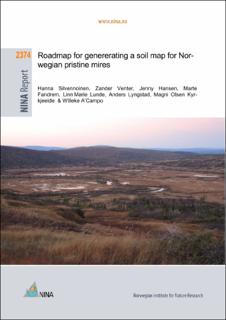| dc.description.abstract | Silvennoinen, H., Venter, Z., Hansen, J., Fandrem, M., Lunde, L.M., Lyngstad, A., Kyrkjeeide, M.O., A’Campo, W. & Nilsen, E. 2023. Roadmap for generating a soil map for Norwegian pristine mires. NINA Report 2374. Norwegian Institute for Nature Research.
Under the umbrella of larger project ‘Økologik tilstand’, we created a roadmap for mapping soil biogeochemistry of Norwegian mires. Mapping soil characteristics, especially carbon and nitrogen stocks as well as their other chemical parameters, as well as physical and biological variables is important to better understand the consequences of various planned disturbances as well as their magnitude.
We searched for the availability of existing Norwegian contemporary and historical data to characterize future data requirements and to test predictive models applying remote sensing tools. To the date, only two datasets are available: a small limited contemporary data set published in Kyrkjeeide et al. (2023) and a large historical dataset collected by ‘Myrselskapet’ (Hovde 1971) and published and stored by NIBIO.
We digitalized and georeferenced this historical dataset, which is now published in Living Norway (Silvennoinen et al. 2023). The consists of various types of peatlands including drained and pristine and used selected parts of it to test the predictive models for mapping carbon and nitrogen densities. This was done as a pilot project to explore the potential for remote sensing and spatial modelling to monitor Norwegian mires. Our pilot study revealed that although we could map carbon and nitrogen densities, the models were attributed with large uncertainties. The models explained between 22 and 24% of the variance in carbon and nitrogen densities. This highlights the need for gathering contemporary in-situ field data for training and ground-truthing remote sensing models before they can be used for developing national soil maps for mires. The limited amount of ‘Myrselskapet’ data which is spatially biased (ie. concentrated in selected areas in Norway) combined with data age (between 61 and 85 years old) makes spatial modelling of mire geochemistry challenging. The dataset is also limited in the amount of data for critical variables, namely peat depth, in order to compute carbon and nitrogen stocks reliably.
Ongoing national soil monitoring programs concentrate on agricultural (JORVAAK - program) and forest soils (‘Overvåking av jordkarbon i skog og beitemark’) but fail to cover pristine mires. To generate a soil map for Norwegian mires, we emphasize the need for contemporary national data for ground-truthing remote sensing modelling methods. At this end, we recommend a onetime intensive sampling campaign (carbon, nitrogen and basic soil physical parameters with vertical and horizontal distribution along with peat depth measurements) for main mire types in Norway to generate a database that can be used to calibrate results from less intensive campaigns with larger geographic coverage. The generated data should be maintained in open access databases.
Estimated costs to generate a national soil map for peatlands are following:
1. Intensive data collection from selected mires to calculate carbon stocks
2. Extensive collection of peat depth data with large national coverage
3. Modelling the soil map
Costs related to point 1 are 1 450 000 kr for sampling of selected 30 mires. These costs include personnel and analysis costs but exclude travel costs. Inclusion of nitrogen analysis will increase the cost estimate by 500 000 kr.
We also recommend that soil depth measurements are included in ongoing soil monitoring programs on peatlands, which have broad national coverage (e.g., ANO). Costs related to point 2. are 75 000 kr per year (coordination, planning and data-analysis), and added field sampling costs of 15 000 - 30 000 kr (without travel costs) per ANO – location. Price per ANO-location varies depending on size and depth of mires at the location. Adding soil sampling (for better recording of carbon stocks) will increase prices per ANO- location by an estimated 10 000 kr.
Costs related to point 3. remote sense modelling of soil carbon content in 3-5 years are estimated to be 800 000 kr – 1 200 000 kr, assuming that data collection presented in points 1 and 2 are carried out.
Current methodology for measuring peat depth (the most critical parameter to quantify soil carbon stocks) is laborious and time consuming. Various methods including landscape modelling and remote sensing are being tested and developed internationally. Building up competence and incorporating such techniques in Norway would significantly expedite developing a comprehensive map for soil carbon stocks in Norwegian mires. | en_US |
